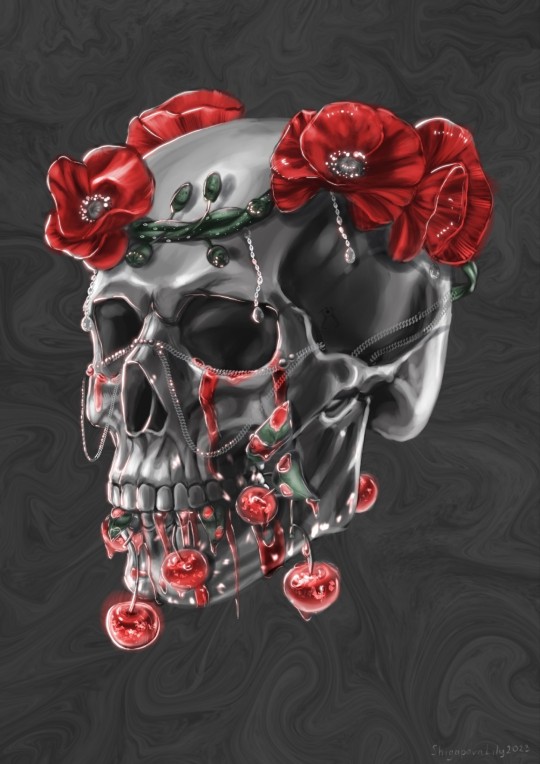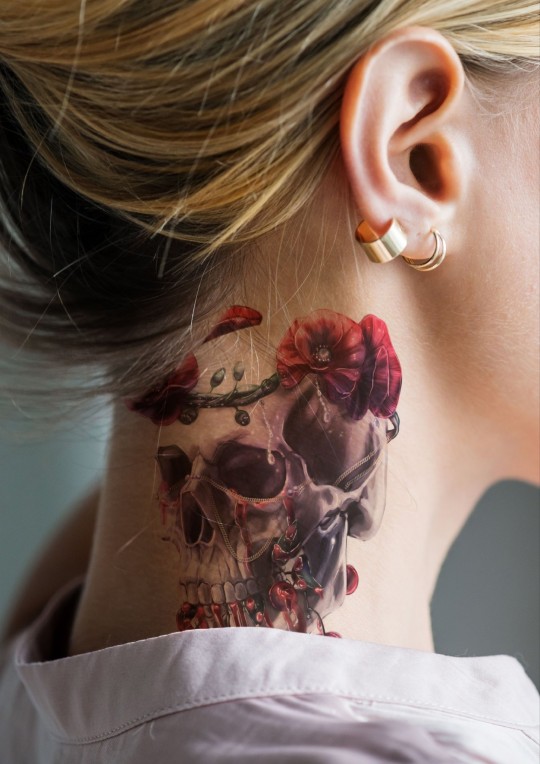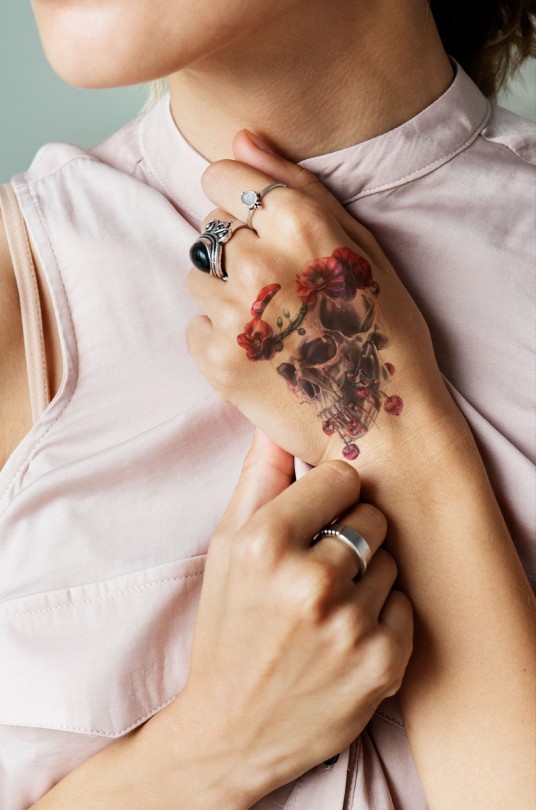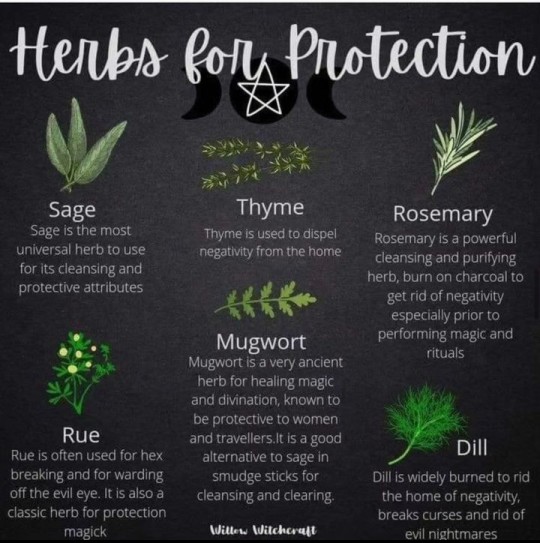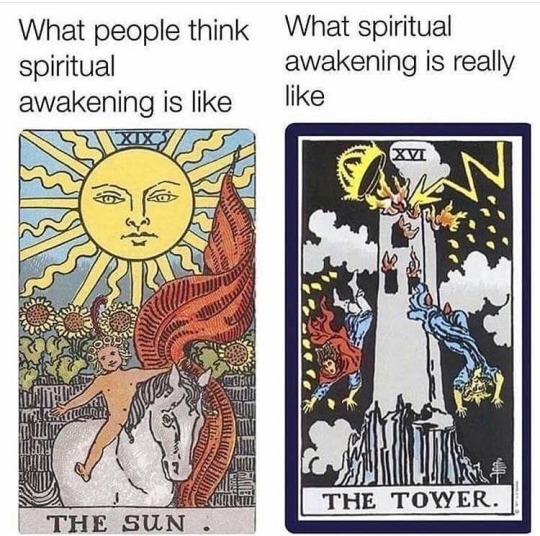Text
The High Priestess Tarot Spread
I perform the comprehensive Celtic Cross spread when reading for others. Because I do not lightly advise a querent, or predict his future, without first letting the cards tell me of his hopes, his fears, his past, his everything.
But when I predict for myself, I use this spread instead.

Step 1: Lay The High Priestess in front of you.
Embody her prophetic powers by gazing at her intently as you shuffle while asking your question.
Step 2: Pull three cards from the top of the deck.
• Card 1 (Ace of Cups) — The irrevocable truth about this person or situation
• Card 2 (The Lovers) — The destined purpose in your life of this person or situation
• Card 3 (Ten of Cups) — The inevitable future that will befall you and this person or situation
Step 3: Turn over the deck.
• Card at the bottom (The Fool) — The reigning energy over you and this person or situation
This is a traditional fortunetelling spread. It is not for the faint of heart. It will show you your future, whether you can handle it or not.
162 notes
·
View notes
Text
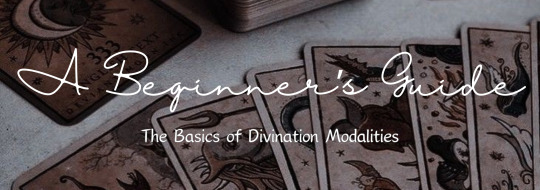
Magicians! Whether you're drawn to tarot cards, crystal balls, or pendulums, there's a divination method out there for everyone. Let's dive into this long post about divination and explore everything you need to know to get started! 🌟
🃏 Tarot Cards:
History: Tarot cards have a rich history dating back to the 15th century, originally used for playing card games. Over time, they evolved into a powerful tool for divination and spiritual insight.
Early Origins: Tarot cards likely originated in the 15th century in Europe, possibly in Italy or France. The earliest known tarot decks were hand-painted luxury items commissioned by wealthy families. These early decks, such as the Visconti-Sforza Tarot and the Tarot de Marseille, were not intended for divination but rather for playing card games similar to modern-day bridges.
Tarot as a Divinatory Tool: By the 18th century, tarot cards began to be used for divination and spiritual purposes. Influential occultists and mystics, such as Antoine Court de Gébelin and Etteilla, popularized the idea that tarot cards held hidden esoteric meanings and could be used for fortune-telling and self-discovery.
The Rider-Waite-Smith Tarot: One of the most iconic and influential tarot decks is the Rider-Waite-Smith Tarot, first published in 1910 by occultist Arthur Edward Waite and artist Pamela Colman Smith. This deck introduced innovative imagery and symbolism, including illustrated scenes on the minor arcana cards, which revolutionized the way tarot was interpreted and understood.
Tarot in Modern Occultism: In the 20th century, tarot experienced a resurgence in popularity within the occult and New Age communities. Influential figures such as Aleister Crowley and Carl Jung explored the psychological and symbolic significance of tarot, further cementing its place as a tool for spiritual insight and personal growth.
Tarot Today: Today, tarot continues to thrive as a popular tool for divination, meditation, and self-reflection. There are countless tarot decks available, ranging from traditional to modern, each with its unique artwork and symbolism. Tarot readers use the cards to explore themes such as love, career, spirituality, and personal development.
💭 Uses: Tarot cards offer guidance, clarity, and introspection. Each card carries its symbolism and meaning, allowing you to tap into your intuition and explore past, present, and future energies.
🃏 Divination: This is perhaps the most well-known use of tarot cards. Divination involves using the cards to gain insight into a specific question or situation. Tarot readers interpret the symbolism and imagery of the cards to provide guidance, clarity, and potential outcomes. Divination readings can focus on various aspects of life, including love, career, relationships, and spiritual growth.
🔍 Self-Reflection and Insight: Tarot cards can serve as powerful tools for self-reflection and introspection. By pulling cards and reflecting on their meanings, individuals can gain insights into their thoughts, emotions, and subconscious mind. Tarot readings can help illuminate patterns, beliefs, and behaviors that may be influencing their lives, allowing for personal growth and transformation.
📖 Decision-Making and Problem-Solving: Tarot cards can be used to help make decisions or solve problems. Individuals can consult the cards for guidance and clarity when faced with a dilemma or uncertainty. Tarot readings can provide different perspectives, highlight potential obstacles or opportunities, and help individuals make more informed choices.
💭 Journaling and Creative Expression: Some people use tarot cards as prompts for journaling or creative expression. They may pull a card each day and write about how its symbolism relates to their experiences, emotions, or goals. Tarot cards can inspire creative projects, artwork, poetry, or storytelling by tapping into the archetypal imagery and themes depicted in the cards.
🙏 Spiritual Development and Meditation: Tarot cards can be incorporated into spiritual practices and meditation routines. Some individuals use tarot cards as focal points for meditation, gazing at the imagery to quiet the mind and deepen their connection to their intuition or spiritual guides. Tarot readings can also be used as part of ritual ceremonies or spiritual rituals to invoke specific energies or intentions.
🌟 Relationship Building and Communication: Tarot cards can be used to build deeper connections and facilitate communication in relationships. Couples or friends may use tarot cards to explore their dynamics, deepen their understanding of each other, and foster open and honest communication. Tarot readings can provide a shared language for discussing feelings, desires, and aspirations.
🧘Manifestation and Goal Setting: Some people use tarot cards as tools for manifestation and goal setting. They may pull cards to clarify their intentions, visualize their desires, and identify action steps to manifest their goals. Tarot readings can help individuals align their thoughts, beliefs, and actions with their desires, empowering them to change their lives positively.
Do's: Trust your intuition, keep an open mind, and approach each reading with respect and reverence.
✅ Set Clear Intentions: Before conducting a tarot reading, take a moment to set clear intentions for the session. Focus on the specific questions or areas of your life you'd like to explore and the guidance you're seeking from the cards.
✅ Cultivate a Sacred Space: Create a sacred and peaceful environment for your tarot readings. Light candles, burn incense or play soft music to enhance the ambiance and set the mood for your practice.
✅ Trust Your Intuition: Tarot readings are as much about intuition as they are about interpretation. Trust your instincts and the messages you receive from the cards. Pay attention to your inner voice and how the cards resonate with your feelings and experiences.
✅ Respect the Cards: Treat your tarot cards with care and respect. Store them in a protective pouch or box when not in use, and avoid handling them with dirty or oily hands. Regularly cleanse and consecrate your cards to maintain their energy and integrity.
✅ Practice Regularly: Like any skill, tarot reading requires practice and dedication. Commit to practicing regularly, even if it's just pulling a daily card or conducting readings for friends and family. The more you work with the cards, the deeper your connection and understanding will become.
✅ Journal Your Readings: Keep a tarot journal to record your readings, interpretations, and insights. Reflect on the messages you receive from the cards and how they resonate with your life. Journaling can help you track your progress, identify patterns, and deepen your understanding of the cards.
✅ Seek Learning and Growth: Tarot is a lifelong journey of learning and exploration. Invest in books, courses, or workshops to deepen your knowledge of tarot symbolism, spreads, and techniques. Surround yourself with a supportive community of fellow tarot enthusiasts to share insights and experiences.
Don'ts: Avoid reading for yourself when in a highly emotional state or seeking answers to overly specific questions. Remember, the cards provide guidance, not concrete predictions.
❌ Don't Read When Emotionally Distressed: Avoid conducting tarot readings when you are feeling highly emotional, anxious, or distressed. Emotions can cloud your judgment and intuition, leading to inaccurate readings or misinterpretations of the cards.
Don't Rely Solely on the Cards: While tarot cards can offer valuable insights and guidance, they should not be seen as infallible or deterministic. Use your judgment, common sense, and critical thinking skills when interpreting the cards and making decisions based on their guidance.
❌ Don't Read for Others Without Permission: Always seek permission before conducting a tarot reading for someone else. Respect their boundaries and privacy, and refrain from prying into sensitive or personal matters without their consent.
Don't Give Unsolicited Advice: Tarot readings are not a substitute for professional advice or therapy. Avoid giving unsolicited advice or making predictions about someone else's future, especially if it could cause harm or distress.
❌ Don't Fear Negative Cards: Every tarot deck contains cards with both positive and challenging symbolism. Don't be afraid of so-called "negative" cards like the Death or Tower card. Instead, embrace them as opportunities for growth, transformation, and new beginnings.
❌ Don't Ignore Your Intuition: If something doesn't feel right during a tarot reading, trust your intuition and proceed with caution. Take breaks when needed, and don't push yourself to continue if you're feeling uncomfortable or overwhelmed.
❌ Don't Become Obsessive: While tarot can be a valuable tool for self-reflection and insight, avoid becoming overly reliant on the cards or obsessed with seeking answers to every question or concern. Balance your tarot practice with other forms of self-care, mindfulness, and spiritual exploration.
🔮Crystal Ball Scrying:
History: Crystal ball scrying dates back to ancient civilizations, including ancient Egypt and Celtic cultures. It involves gazing into a crystal ball to receive visions or insights.
📜 Ancient Roots: The practice of scrying dates back thousands of years and can be found in cultures across the globe. Ancient civilizations such as the Egyptians, Greeks, Romans, and Druids all had forms of divination involving reflective surfaces or natural objects. These practices often involved seeking guidance from spirits, deities, or ancestors through the act of gazing into a reflective medium.
🏛️ Medieval Europe: Crystal ball scrying gained popularity during the Middle Ages in Europe, particularly among alchemists, astrologers, and mystics. It was believed that certain stones, such as quartz crystals, possessed mystical properties and could serve as conduits for receiving divine or spiritual messages. Crystal balls became associated with the concept of the "scrying mirror," a tool for accessing hidden knowledge and insights beyond the physical realm.
⏳ Renaissance and Occult Revival: During the Renaissance and the occult revival of the 19th century, crystal ball scrying experienced a resurgence of interest among mystics, occultists, and spiritual seekers. Influential figures such as John Dee, Edward Kelley, and Aleister Crowley explored the practice of scrying as a means of contacting spirits, exploring the subconscious mind, and gaining occult knowledge.
🌍 Victorian Era and Spiritualism: Crystal ball scrying gained popularity during the Victorian era, particularly within the spiritualist movement. Mediums and psychics used crystal balls as tools for communicating with the spirit world and conducting seances. The crystal ball became synonymous with the image of the "fortune-teller" or "gypsy" depicted in popular culture and folklore.
📚 Modern Practice: Today, crystal ball scrying continues to be practiced by psychics, mediums, and individuals interested in divination and spiritual exploration. While traditional crystal balls made of quartz or glass are still used, practitioners may also use other reflective surfaces such as mirrors, black obsidian, or bowls of water. Crystal ball scrying is often incorporated into rituals, meditation practices, or psychic readings as a means of accessing intuitive insights and guidance.
Uses: Crystal ball scrying is a powerful method for accessing the subconscious mind and receiving intuitive guidance. It can be used for divination, meditation, and spiritual exploration.
🔮 Divination: The primary use of crystal ball scrying is for divination, or gaining insight into past, present, or future events. By gazing into the crystal ball and allowing the mind to relax and enter a meditative state, practitioners may receive intuitive impressions, symbols, or visions that provide guidance, clarity, and understanding. Crystal ball readings can address a wide range of questions or concerns, including love, career, health, and spiritual growth.
💬 Personal Reflection: Crystal ball scrying can be used for personal reflection and introspection. By gazing into the crystal ball and allowing thoughts and images to arise spontaneously, individuals can gain insights into their emotions, beliefs, and subconscious minds. Crystal ball scrying can help individuals explore their innermost thoughts, fears, and desires, leading to greater self-awareness and personal growth.
🙏 Spiritual Exploration: Crystal ball scrying can serve as a tool for spiritual exploration and connection. Some practitioners use the crystal ball to commune with spirit guides, angels, or ancestors, seeking wisdom, guidance, and inspiration from the spiritual realm. Crystal ball scrying can facilitate a deeper connection to one's intuition, higher self, or spiritual allies, fostering a sense of inner peace, alignment, and purpose.
Problem-Solving and Decision-Making: Crystal ball scrying can be used as a tool for problem-solving and decision-making. By focusing on a specific question or dilemma and gazing into the crystal ball, individuals may receive insights, solutions, or alternative perspectives that help them make informed choices or overcome obstacles in their lives. Crystal ball scrying can provide clarity, direction, and confidence when facing difficult decisions or challenges.
💡 Energy Healing: Some practitioners use crystal ball scrying as part of energy healing or therapeutic practices. By incorporating the crystal ball into meditation or visualization, individuals can channel healing energy and intention through the crystal, promoting relaxation, balance, and harmony on physical, emotional, and spiritual levels. Crystal ball scrying can enhance the healing process and support overall well-being and vitality.
🌟 Ritual and Ceremony: Crystal ball scrying can be incorporated into ritual and ceremonial practices as a means of invoking spiritual energies, setting intentions, or communing with the divine. Some traditions use the crystal ball as a focal point for meditation, prayer, or spellcasting, harnessing its reflective properties to amplify intention and manifest desired outcomes. Crystal ball scrying can enhance the sacredness and potency of ritual practices, deepening the practitioner's connection to the divine and the unseen realms.
Do's: Create a sacred space, cleanse your crystal ball before use, and practice relaxation techniques to quiet the mind.
✅ Prepare Your Space: Create a calm and sacred space for your scrying practice. Dim the lights, burn incense or candles, and eliminate distractions to create an environment conducive to relaxation and focus.
✅ Cleanse and Charge Your Crystal Ball: Before each scrying session, cleanse your crystal ball to remove any negative or stagnant energies it may have absorbed. You can cleanse it with smoke (such as herb bundles of cedar, garden sage, or rosemary), sound (using a singing bowl or bell), or by placing it under running water. Once cleansed, charge the crystal ball with your intention or positive energy.
✅ Set Clear Intentions: Clarify your intentions before beginning your scrying session. Think about the questions or areas of your life you'd like to explore and focus your energy and attention on receiving guidance and insights from the crystal ball.
✅ Relax and Clear Your Mind: Relax your body and mind before gazing into the crystal ball. Practice deep breathing or meditation techniques to quiet your thoughts and enter a receptive state of awareness. Release any expectations or preconceived notions, allowing yourself to be open to whatever messages or images may arise.
✅ Trust Your Intuition: Trust your inner guidance and intuition during the scrying process. Pay attention to any impressions, feelings, or images that come to you as you gaze into the crystal ball. Trust that the messages you receive are meaningful and relevant to your journey.
✅ Journal Your Insights: Keep a journal to record your scrying experiences, insights, and interpretations. Writing down your impressions can help you track patterns, themes, and symbols that emerge over time, deepening your understanding of the messages received from the crystal ball.
Don'ts: Avoid forcing visions or expecting immediate results. Patience and practice are key when it comes to crystal ball scrying.
❌ Force the Process: Avoid trying to force or control the scrying process. Allow the images and impressions to arise naturally, without imposing your will or expectations onto the experience. Trust that the messages will come to you in their own time and in their way.
❌ Scry When Emotionally Distressed: Refrain from scrying when you're feeling highly emotional, anxious, or stressed. Strong emotions can cloud your judgment and intuition, making it difficult to receive clear and accurate guidance from the crystal ball.
❌ Obsess Over Negative Images: If you encounter negative or unsettling images during your scrying session, don't dwell on them or become fixated on their meaning. Instead, acknowledge the images and release them with love and compassion. Focus on inviting positive and uplifting energy into your space.
Interpret Too Literally: Avoid interpreting the images or symbols in the crystal ball too literally. Instead, focus on the overall feeling or message conveyed by the imagery. Allow your intuition to guide you in discerning the deeper meaning behind the symbols and their relevance to your life.
❌ Compare Your Experience to Others: Every scrying experience is unique to the individual. Avoid comparing your experience to that of others or seeking validation from external sources. Trust in your insights and interpretations, knowing that you are the ultimate authority on your spiritual journey.
❌ Overuse or Depend Solely on the Crystal Ball: While crystal ball scrying can be a valuable tool for spiritual growth and insight, avoid becoming overly reliant on the crystal ball or using it as a crutch. Balance your scrying practice with other forms of divination, meditation, and self-reflection to maintain a holistic approach to your spiritual development.
⚖️ Pendulum Divination:
History: Pendulum divination has been used for centuries to seek answers and guidance from the subconscious mind. It involves suspending a pendulum over a surface and interpreting its movements.
📜 Ancient Origins: Dowsing, the broader term encompassing pendulum divination, has ancient roots and is believed to have originated independently in different cultures. Archaeological evidence suggests that dowsing tools, such as forked branches or rods, were used by ancient civilizations for locating water sources, minerals, and other hidden resources. Dowsing was often practiced by individuals known as "water witches" or "diviners" who possessed a special sensitivity to subtle energies or vibrations in the earth.
🏛️ Historical References: References to dowsing can be found in historical texts and records dating back thousands of years. For example, ancient Egyptian texts describe the use of dowsing rods for finding water and minerals, while ancient Chinese texts mention the use of divining rods for locating underground sources of water. Dowsing was also practiced by European cultures during the Middle Ages and Renaissance periods, where it was used for everything from locating buried treasure to identifying witches.
⏳ Renaissance and Enlightenment: During the Renaissance and Enlightenment periods, dowsing experienced a resurgence of interest and popularity among scholars, scientists, and natural philosophers. Figures such as Leonardo da Vinci, Sir Isaac Newton, and Paracelsus explored the phenomenon of dowsing and its potential applications in various fields. Dowsing was studied alongside other forms of natural philosophy and was often associated with concepts of magnetism, subtle energies, and the human psyche.
🌍 19th Century and Spiritualism: In the 19th century, dowsing became closely associated with the spiritualist movement, which emphasized communication with the spirit world and exploration of psychic phenomena. Mediums and psychics used pendulums as tools for divination, communication with spirits, and accessing intuitive insights. Pendulum divination was integrated into seances, spiritual healing practices, and other spiritualist rituals as a means of receiving guidance and validation from the unseen realms.
📚 Modern Practice: Today, pendulum divination remains a popular and widely practiced form of divination, utilized by people of various spiritual and cultural backgrounds. Pendulums come in a variety of shapes, sizes, and materials, including metal, wood, and crystal. Practitioners use pendulums for a wide range of purposes, including divination, decision-making, energy healing, and spiritual exploration. Pendulum divination is often integrated into holistic healing modalities such as Reiki, chakra balancing, and aura cleansing, as well as used in conjunction with other forms of divination such as tarot cards or astrology.
Uses: Pendulums can be used for yes/no questions, dowsing, and accessing intuitive knowledge. They are versatile tools for divination and spiritual exploration.
⚖️ Answering Questions: One of the primary uses of pendulum divination is to seek answers to questions. By asking yes/no questions and observing the movement of the pendulum, practitioners can receive guidance and insight into various aspects of their lives, including relationships, careers, health, and spiritual matters. Pendulum divination can provide clarity and direction when faced with difficult decisions or uncertainties.
🕰️ Decision-Making: Pendulum divination can be a helpful tool for making decisions. Practitioners can use the pendulum to weigh different options, evaluate potential outcomes, and determine the best course of action. By tuning into their intuition and allowing the pendulum to guide them, individuals can make more informed choices that align with their highest good.
💫 Problem-Solving: Pendulum divination can assist in problem-solving and troubleshooting. By focusing on a specific issue or challenge and asking targeted questions, practitioners can uncover underlying causes, identify solutions, and overcome obstacles more effectively. Pendulum divination can reveal hidden insights and perspectives that may not be immediately apparent, leading to creative solutions and breakthroughs.
🌀 Aura and Energy Work: Pendulum divination can be incorporated into energy healing and aura work. Practitioners can use the pendulum to detect and assess subtle energy patterns, blockages, or imbalances within the body's energy field. By observing the movement of the pendulum, individuals can identify areas of tension or stagnation and channel healing energy to restore balance and harmony on physical, emotional, and spiritual levels.
🌈 Personal Growth and Self-Discovery: Pendulum divination can serve as a tool for personal growth and self-discovery. By asking questions related to inner thoughts, emotions, and beliefs, individuals can gain insight into their subconscious mind and explore areas of self-improvement and healing. Pendulum divination can help individuals uncover limiting beliefs, release emotional blocks, and cultivate greater self-awareness and empowerment.
🌟Spiritual Exploration: Pendulum divination can be used for spiritual exploration and connection. Practitioners can use the pendulum to communicate with spirit guides, angels, or higher consciousness, seeking guidance, wisdom, and support from the spiritual realms. Pendulum divination can deepen one's connection to the divine and facilitate a greater sense of trust, faith, and alignment with universal energies.
Do's: Establish clear communication with your pendulum, ask concise questions, and trust the answers you receive.
✅ Set Clear Intentions: Before beginning a pendulum divination session, take a moment to set clear intentions for the process. Clarify the questions or areas of your life you'd like to explore and the guidance you're seeking from the pendulum. Focus your energy and attention on receiving clear and accurate answers.
✅ Choose a Suitable Pendulum: Select a pendulum that resonates with you energetically and feels comfortable to use. Pendulums come in various shapes, sizes, and materials, so choose one that feels intuitively right for you. You may also choose to cleanse and consecrate your pendulum before using it to remove any previous energies and imbue it with your intention.
✅ Establish Clear Communication: Before beginning your divination session, establish clear communication with your pendulum. Hold the pendulum in your hand and ask it to show you a clear and accurate response for "yes" and "no" movements. Observe how the pendulum responds to different questions and affirmations, trusting the movements as indications of intuitive guidance.
✅ Practice Grounding and Centering: Ground and center yourself before engaging in pendulum divination. Take a few deep breaths, visualize roots extending from your body into the earth, and imagine yourself surrounded by a protective bubble of light. Grounding helps to stabilize your energy and enhance your connection to the pendulum and your intuition.
✅ Trust Your Intuition: Trust your inner guidance and intuition throughout the pendulum divination process. Pay attention to any intuitive impressions, feelings, or insights that arise as you work with the pendulum. Trust that the messages you receive are meaningful and relevant to your situation, even if they may not always align with your expectations.
✅ Maintain Respect and Ethical Conduct: Treat the pendulum with respect and reverence as a sacred tool for divination. Approach the process with sincerity, honesty, and integrity, refraining from asking frivolous or inappropriate questions. Avoid using pendulum divination to manipulate or control others or to pry into sensitive or private matters without their consent.
Don'ts: Avoid relying solely on the pendulum for major life decisions or asking questions that are too vague or ambiguous.
❌ Don't Engage When Emotionally Distressed: Avoid engaging in pendulum divination when you're feeling highly emotional, anxious, or stressed. Strong emotions can cloud your judgment and intuition, leading to inaccurate or unreliable readings. Wait until you're in a calm and centered state before using the pendulum for divination.
❌ Don't Rely Solely on the Pendulum: While the pendulum can be a valuable tool for accessing intuitive guidance, avoid becoming overly reliant on it or using it as a substitute for your inner wisdom. Use the pendulum as a complementary tool alongside your intuition, critical thinking skills, and common sense when making decisions or seeking guidance.
❌ Don't Forget to Ground and Close: After completing a pendulum divination session, remember to ground yourself and close your energy. Thank the pendulum for its guidance and assistance, and express gratitude for the insights received. Release any residual energy or attachments and return to a grounded state of awareness before continuing with your day.
❌ Don't Obsess Over Negative Outcomes: If you receive a negative or unsettling response from the pendulum, don't dwell on it or become overly fixated on the outcome. Remember that pendulum divination is a tool for guidance and insight, not a predictor of fixed outcomes. Trust that the messages you receive are meant to serve your highest good and empower you to make informed choices.
❌ Don't Compare Your Results to Others: Every individual's experience with pendulum divination is unique. Avoid comparing your results or interpretations to those of others, as each person's energy, intuition, and circumstances are different. Trust in your intuition and interpretation of the pendulum's movements, knowing that you are the ultimate authority on your spiritual journey.
There are other modalities that I haven't covered in depth. Let's touch a bit on each of these main ones:
Scrying: Scrying is a broad term encompassing various divinatory practices involving gazing into reflective surfaces or mediums to receive insights or visions. In addition to crystal ball scrying, other forms of scrying include using mirrors, water, fire, smoke, or black mirrors to access intuitive guidance and symbolic imagery. I touched on specifically crystal ball scrying, but there are many other types of scrying to fit your needs, the basics are mostly the same.
Astrology: Astrology is the study of celestial bodies' positions and movements to interpret their influence on human affairs and natural phenomena. Astrologers use birth charts, horoscopes, and planetary alignments to provide insights into personality traits, life events, and compatibility.
Numerology: Numerology is the study of numbers and their symbolic meanings. Numerologists analyze numbers associated with names, birthdates, and events to uncover insights into personality, life paths, and potential outcomes. Numerology can involve calculations such as life path numbers, destiny numbers, and personal year cycles.
Palmistry: Palmistry is the practice of reading the lines, shapes, and markings on the palms of the hands to gain insight into personality traits, life events, and potential future outcomes. Palmists examine features such as palm lines (e.g., heart line, head line), mounts, and finger shapes to provide interpretations.
Runes: Runes are ancient symbols used in divination, originating from Germanic and Norse cultures. Runecasters typically use sets of carved stones or wooden tiles inscribed with runic symbols. By casting or drawing runes and interpreting their positions and meanings, practitioners can gain insights into various aspects of life and decision-making.
Tea Leaf Reading (Tasseography): Tasseography is the practice of interpreting patterns and symbols formed by tea leaves at the bottom of a cup or vessel. Practitioners observe the shapes, lines, and arrangements of the tea leaves to provide insights into future events, emotions, and outcomes.
Cartomancy: Cartomancy is the practice of using regular playing cards or specialized decks (other than tarot cards) for divination purposes. Practitioners interpret the suits, numbers, and symbols on the cards to provide insights into past, present, or future events and circumstances.
Dream Interpretation: Dream interpretation involves analyzing the symbols, themes, and emotions present in dreams to gain insights into the dreamer's subconscious mind and waking life. Dream interpreters use various techniques and frameworks to interpret dreams and uncover their meanings and messages.
I primarily use tarot and pendulum divination as well as black mirror scrying, however, the basic understanding of many types of divination can allow you to become a well-rounded practitioner.
134 notes
·
View notes
Text
Protection spells are utilized by witches to safeguard themselves and others from negative energy and harm. Here are a few examples:
Circle of Protection: This spell involves creating a circle of salt or herbs around oneself or a specific area to create a barrier against negative forces.
Shielding Spell: This spell requires visualizing a protective shield of light or energy around oneself to deflect any negative influences.
Warding Spell: By placing protective symbols or objects in a specific area, this spell prevents unwanted energies or entities from entering.
Banishing Spell: This spell removes negative energies or entities from a person or place by using incantations, herbs, or rituals.
Remember, it is important to use these spells responsibly and with good intentions.
From www.poemsplease.com

588 notes
·
View notes
Text
✨ Tarot Deck Review ✨

"The Magical Nordic Tarot"
By Jayne Wallace
Deck contains 79 cards
Includes a 64 page guide book
Major Arcana have traditional names
Court cards: Page, Knight, Queen, King
Suits: Pentacles, Cups, Wands, Swords
The guidebook, for each card, elaborates with sections: Keywords, Message, Meaning; as well as a description of the cards artwork and symbolism.
The box is a hard cardboard material, which I personally like.
The card material is very glossy and shiney, a little too slippery for my taste, but everyone has their own preference when it comes to the card stock!
Art work is beautiful! Inspired by old Nordic folklore and myths, it offers a unique telling of interpretations.
The 79 cards is one more than the traditional 78. This is in thank you to Tracey Emin's special addition of the 79th card included.
The minor arcana cards are not fully illustrated - this is a problem for some readers and how their minds interpret the cards. But you can make your own opinion!
As far as ease of reading; I personally did not really find myself connecting to the artwork. But that is a ME issue - everyone is different. Still very beautiful.
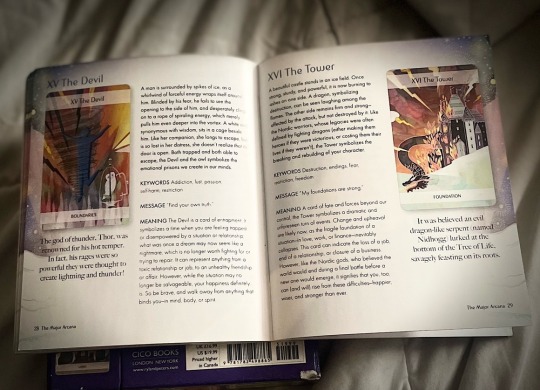

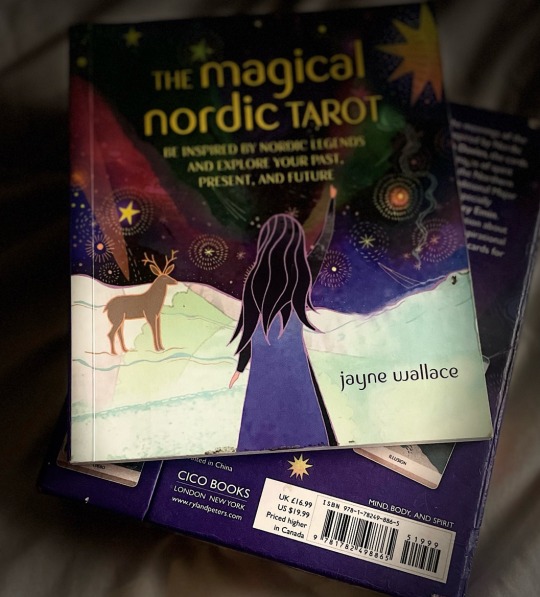

8 notes
·
View notes
Text

Six of Swords.
In order to move forward, you must first come to terms with the fact that some things will be left behind.
166 notes
·
View notes
Photo

Blossom & Thorn Spread 🛣️
The blossom: What should I allow to blossom?
The thorn: How can I better protect myself in the process?
The sap: Why does it need to blossom?
The blood: Why do I need to be protected?
I have greatly enjoyed designing and using this spread. I hope you do, too.
2K notes
·
View notes
Text
A quick reminder that it is perfectly okay to still go to your tarot guide in the middle of a reading, no matter how advanced you are in divination. It’s okay, even, to go to more than one guide if you’re not sure that the first one’s description was accurate to the context. Tarot is all about following your intuition and doing what you feel it’s right.
629 notes
·
View notes
Photo

The Seed.
a tarot spread for ostara.
1. The Soil.
Where have you grown? While it most certainly is the dawn of a new day, keep in mind your roots are proof that you have already come a long way. The soil is your past. What lesson can you learn from days gone by?
2. The Weed.
You wish to flourish and grow strong, but there is undoubtedly something that is stunting your progress. What are your obstacles, what’s holding you back?
3. The Seed.
Within your immediate future, which area of your life will you first see signs of growth? Which seed has taken hold?
4. The Sun.
The love and support of others is helpful. But the will to grow comes from within. Let the sun be a reminder of what you need to keep in mind in order to help yourself grow.
5. The Rain.
A blessing in disguise. Understand that not all things are always as they seem. Grey skies can sometimes bring you down, but like the sun, rain too is necessary. Through struggle, you will find strength. What blessing in disguise is upon your horizon?
10K notes
·
View notes
Text
How many decks should you have?
As many as you can love.
Someone who has 100 decks and uses them all is being more respectful towards the craft than someone who only has two decks but rarely uses one of them. All you have to do is ensure that all your decks are regularly consulted, and that none of them is left to rot on a shelf.
1) Do not buy a deck you are not completely enchanted by. If you do not love it at first sight, you will likely end up setting it aside.
2) Avoid owning similar decks. I only have one pocket-size tarot deck, and one that is giant-size. Give each a chance to be unique.
3) Know that a gifted deck is a deck that chose you. Even if you do not like its design, find a way to love it, the way it found its way to you.
4) Store your decks in a queue. Before you read, get the one in front. Afterwards, put it in the back. This way, you get to use the whole stack.
5) Learn each of your decks. If you have not yet mastered your first two, do not acquire a third. Be a cartomancer, not a hoarder.
Tarot is the proudest of all cartomancy instruments. But this also applies to Lenormand, Sibilla and oracle decks.
132 notes
·
View notes
Text
How to Decide Which Tarot Card Meaning to Use
It is a one-step process. Just keep in mind the context.
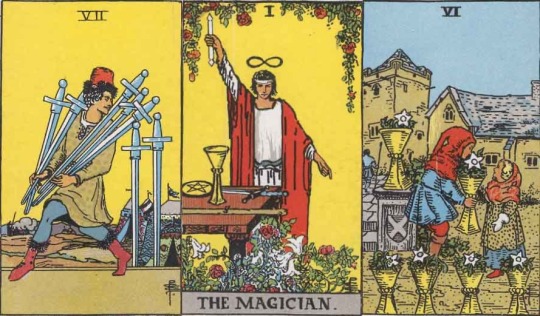
SEVEN OF SWORDS
“Can I trust this person?” “No. He is sneaky.”
“Will he like my cooking?” “Yes, he will even bring home leftovers.”
How come one is a no, and the other is a yes? Because the context of the first question is trust. And the imagery in the card is a thief. Thieves are not to be trusted. But the context of the second one is enjoyment. And the man in the card, with stolen goods in hand, is clearly enjoying what he is doing.
THE MAGICIAN
“Will I achieve my dreams?” “Yes, you will.”
“Will my opponent outshine me?” “Yes, she will.”
How come one is good for you and the other is bad? Because the context of the first question is you. You become The Magician. The context of the second question is your rival. She embodies The Magician's power.
SIX OF CUPS
“How will I feel in this relationship?” “Happy and carefree.”
“What will I hate about him?” “He is privileged and childish.”
Why is one sweet and the other not quite? Because the context of the first question is a feeling. And the imagery in the card has a light and joyful feel. But the context of the second one is negative. So search for what is amiss: spoiled and privileged children.
345 notes
·
View notes
Text
How to Do the Major Arcana Grand Tableau
This spread uses all the Major Arcana to give you an overview of your whole year ahead. It is best performed on your birthday or on New Year’s Eve.
STEP 1: Lay out the Major Arcana in order.
Line 1: The Fool to The Lovers
Line 2: The Chariot to The Hanged Man
Line 3: Death to The Star
Line 4: The Moon to The World

STEP 2: Shuffle the Minor Arcana.
As you do this, ask your higher power to show you a glimpse of your destiny for the upcoming year.
STEP 3: Draw a Minor for each Major.
One by one, take 21 cards from the top of the deck and place them over the Major Arcana, starting with The Fool. Then take the card at the bottom of the deck, and place it over The World.
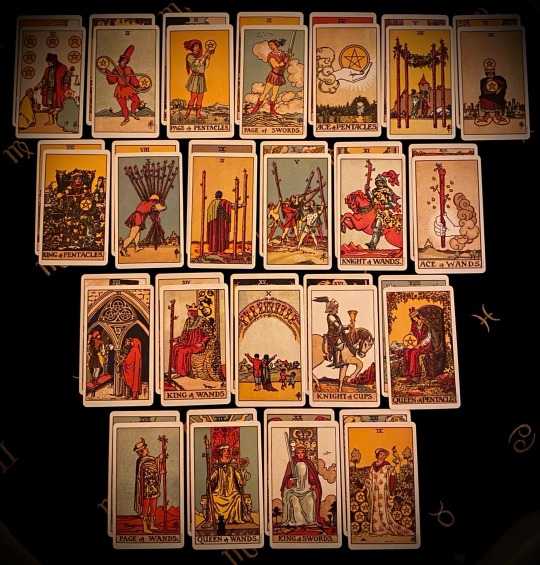
STEP 4: Read the Minor against the Major.
The Major Arcana represent the important aspects of your life. The Minor Arcana reveal what will take place within these aspects.
The Fool – What will begin in your life?
The Magician – What dream will manifest?
The High Priestess – What secret will be uncovered?
The Empress – What will you harvest?
The Emperor – What will you have control over?
The Hierophant – What will remain unchanged?
The Lovers – How will your love life be?
The Chariot – What will make you victorious?
Strength – Where will you find strength?
The Hermit – What will you need to reflect on?
Wheel of Fortune – Where will you find luck?
Justice – Who will avenge you?
The Hanged Man – What will you have to sacrifice?
Death – What will be reborn?
Temperance – What will bring balance into your life?
The Devil – What will you be most passionate about?
The Tower – What will trigger a profound change?
The Star – Where will you find hope?
The Moon – What will stay clouded?
The Sun – What will bring you joy?
Judgement – Which of your oppressors will be punished?
The World – What will give you a sense of accomplishment?
Sample Interpretation:
The Four of Pentacles on The Lovers – “Your romantic partner will be very protective of you, maybe even to the point of being possessive.”
The Ace of Wands on The Hanged Man – “You will need to sacrifice a part of your career or pause a project you are passionate about.”
The Ten of Cups on The Devil – “You will be focusing all your attention and energy on starting or expanding your family.”
If we tie it all together, we arrive at: “You will get pregnant this year, prompting you to leave your stressful though fulfilling job, so you could focus instead on ensuring you have optimal health to carry the baby to term. During your pregnancy, your spouse will be taking care of you even more than before.”
STEP 5: Identify the court cards.
The Kings, Queens and Knights are the people who will play a vital role in your life, positively or otherwise.
King of Wands – Leo (Fixed Fire)
Queen of Wands – Aries (Cardinal Fire)
Knight of Wands – Sagittarius (Mutable Fire)
King of Cups – Scorpio (Fixed Water)
Queen of Cups – Cancer (Cardinal Water)
Knight of Cups – Pisces (Mutable Water)
King of Swords – Aquarius (Fixed Air)
Queen of Swords – Libra (Cardinal Air)
Knight of Swords – Gemini (Mutable Air)
King of Pentacles – Taurus (Fixed Earth)
Queen of Pentacles – Capricorn (Cardinal Earth)
Knight of Pentacles – Virgo (Mutable Earth)
Sample Interpretation:
There are two couples here — the King and Queen of Wands and the King and Queen of Pentacles: “You and your other half will be highly supportive of each other. You could be a Taurus and they could be an Aries, or vice versa. Either way, you will strongly feel the love and passion in your relationship.”
STEP 6: Notice the dominant suit.
Wands – Passion will overflow.
Cups – Emotions run the show.
Swords – The battle is in your mind.
Pentacles – Finances will be bright.
Sample Interpretation:
There are nine Wands and nine Pentacles each: “Your year will definitely not be lacking in passion and stability — materially and emotionally.”
STEP 7: Note the numbers that appear at least thrice.
Aces – A year of beginnings
Twos – A year of dilemmas
Threes – A year of affairs
Fours – A year of stability
Fives – A year of changes
Sixes – A year of harmony
Sevens – A year of challenges
Eights – A year of labor
Nines – A year of completion
Tens – A year of harvest
Sample Interpretation:
No number appeared more than twice. There is no discernible theme, numerology-wise.
STEP 8: Observe the ruling colors.
Black – Loneliness, regret, obstacles, purging
Red, Yellow, Orange – Passion, love, happiness, power
Blue, White, Green – Spirituality, logic, innocence, intuition
Sample Interpretation:
Red, yellow and orange are the ruling colors: “Your year will be filled with a passionate love that will bring you joy and a strong sense of control over your life.”
STEP 9: Record your grand tableau.
Take a photograph of your spread, and write down your interpretations of it.
STEP 10: Review your grand tableau.
At the end of each quarter, note which predictions have come true. By the end of the year, compare your interpretations to how the spread manifested. Doing so allows you to reflect on your past year, and improves your divination skills.
2K notes
·
View notes
Text
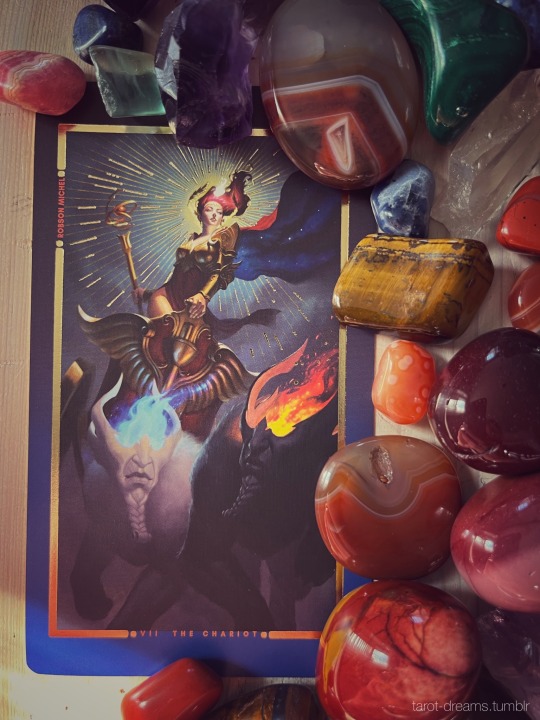
The Chariot.
Let unshakeable determination be yours. With confidence as your compass, know that you will never be lost. Intellect is the strength physical might will never possess. Do not allow yourself to fall victim to the belief that there is any obstacle you can’t conquer.
114 notes
·
View notes


